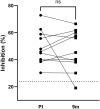The Secretory IgA Response in Human Milk Against the SARS-CoV-2 Spike Is Highly Durable and Neutralizing for At Least 1 Year of Lactation Postinfection
- PMID: 37615565
- PMCID: PMC10460685
- DOI: 10.1089/bfm.2023.0117
The Secretory IgA Response in Human Milk Against the SARS-CoV-2 Spike Is Highly Durable and Neutralizing for At Least 1 Year of Lactation Postinfection
Abstract
Background: Although in the early pandemic period COVID-19 pathology among young children and infants was typically less severe compared with that observed among adults, this has not remained entirely consistent as severe acute respiratory syndrome coronavirus 2 (SARS-CoV-2) variants have emerged. There is an enormous body of evidence demonstrating the benefits of human milk antibodies (Abs) in protecting infants against a wide range of enteric and respiratory infections. It is highly plausible that the same holds true for protection against SARS-CoV-2 as this virus infects cells of the gastrointestinal and respiratory mucosae. Understanding the durability of a human milk Ab response over time after infection is critical. Objective: Previously, we examined the Abs present in milk of those recently infected with SARS-CoV-2 and concluded that the response was secretory immunoglobulin A (sIgA) dominant and that these titers were highly correlated with neutralization potency. The present study aimed to monitor the durability of the SARS-CoV-2 IgA and secretory Ab (sAb) response in milk from COVID-19-recovered lactating individuals over 12 months in the absence of vaccination or reinfection. Results: This analysis revealed a robust and durable spike-specific milk sIgA response, and at 9-12 months after infection, 88% of the samples exhibited titers above the positive cutoff for IgA and 94% were above the cutoff for sAb. Fifty percent of participants exhibited less than twofold reduction of spike-specific IgA through 12 months. A strong, significant positive correlation between IgA and sAb against spike persisted throughout the study period. Nucleocapsid-specific Abs were also assessed, which revealed significant background or cross-reactivity of milk IgA against this immunogen, as well as limited/inconsistent durability compared with Spike titers. Conclusion: These data suggest that lactating individuals are likely to continue producing spike-specific Abs in their milk for 1 year or more, which may provide critical passive immunity to infants against SARS-CoV-2 throughout the lactation period.
Keywords: COVID-19; SARS-CoV-2; antibodies; human milk; lactation; secretory IgA.
Conflict of interest statement
The authors declare that the research was conducted in the absence of any commercial or financial relationships that could be construed as potential conflicts of interest.
Figures




Update of
-
The secretory IgA (sIgA) response in human milk against the SARS-CoV-2 Spike is highly durable and neutralizing for at least 1 year of lactation post-infection.medRxiv [Preprint]. 2023 May 26:2023.05.19.23290192. doi: 10.1101/2023.05.19.23290192. medRxiv. 2023. Update in: Breastfeed Med. 2023 Aug;18(8):602-611. doi: 10.1089/bfm.2023.0117. PMID: 37293109 Free PMC article. Updated. Preprint.
Similar articles
-
The secretory IgA (sIgA) response in human milk against the SARS-CoV-2 Spike is highly durable and neutralizing for at least 1 year of lactation post-infection.medRxiv [Preprint]. 2023 May 26:2023.05.19.23290192. doi: 10.1101/2023.05.19.23290192. medRxiv. 2023. Update in: Breastfeed Med. 2023 Aug;18(8):602-611. doi: 10.1089/bfm.2023.0117. PMID: 37293109 Free PMC article. Updated. Preprint.
-
The IgA in milk induced by SARS-CoV-2 infection is comprised of mainly secretory antibody that is neutralizing and highly durable over time.PLoS One. 2022 Mar 9;17(3):e0249723. doi: 10.1371/journal.pone.0249723. eCollection 2022. PLoS One. 2022. PMID: 35263323 Free PMC article.
-
Comparative Profiles of SARS-CoV-2 Spike-Specific Human Milk Antibodies Elicited by mRNA- and Adenovirus-Based COVID-19 Vaccines.Breastfeed Med. 2022 Aug;17(8):638-646. doi: 10.1089/bfm.2022.0019. Epub 2022 Jun 8. Breastfeed Med. 2022. PMID: 35675683
-
Maternal vaccination as an additional approach to improve the protection of the nursling: Anti-infective properties of breast milk.Clinics (Sao Paulo). 2022 Aug 10;77:100093. doi: 10.1016/j.clinsp.2022.100093. eCollection 2022. Clinics (Sao Paulo). 2022. PMID: 35963149 Free PMC article. Review.
-
Effects of Vaccination Against Influenza, Pertussis, and COVID-19 on Human Milk Antibodies: Current Evidence and Implications for Health Equity.Front Immunol. 2022 Jul 12;13:910383. doi: 10.3389/fimmu.2022.910383. eCollection 2022. Front Immunol. 2022. PMID: 35903100 Free PMC article. Review.
Cited by
-
A case series exploring the human milk polyclonal IgA1 response to repeated SARS-CoV-2 vaccinations by LC-MS based fab profiling.Front Nutr. 2024 Jan 15;10:1305086. doi: 10.3389/fnut.2023.1305086. eCollection 2023. Front Nutr. 2024. PMID: 38288064 Free PMC article.
-
Unique Kinetics of the Human Milk Antibody Response to JYNNEOS Vaccine for Prevention of Monkey Pox: A Case Study.Breastfeed Med. 2024 Dec;19(12):974-979. doi: 10.1089/bfm.2024.0257. Epub 2024 Oct 2. Breastfeed Med. 2024. PMID: 39360771
-
In vivo antiviral efficacy of LCTG-002, a pooled, purified human milk secretory IgA product, against SARS-CoV-2 in a murine model of COVID-19.Hum Vaccin Immunother. 2024 Dec 31;20(1):2303226. doi: 10.1080/21645515.2024.2303226. Epub 2024 Jan 22. Hum Vaccin Immunother. 2024. PMID: 38251677 Free PMC article.
-
Dynamic Changes in Antibodies and Proteome in Breast Milk of Mothers Infected with Wild-Type SARS-CoV-2 and Omicron: A Longitudinal Study.Nutrients. 2025 Apr 21;17(8):1396. doi: 10.3390/nu17081396. Nutrients. 2025. PMID: 40284260 Free PMC article.
-
Impact of Maternal Exposure to SARS-CoV-2 on Immunological Components of Breast Milk.Int J Mol Sci. 2025 Mar 13;26(6):2600. doi: 10.3390/ijms26062600. Int J Mol Sci. 2025. PMID: 40141241 Free PMC article. Review.
References
-
- Centers for Disease Control and Prevention. COVID Data Tracker. April 18 ed. US Department of Health and Human Services, CDC: Atlanta, GA, USA; 2023.
Publication types
MeSH terms
Substances
Grants and funding
LinkOut - more resources
Full Text Sources
Medical
Miscellaneous

